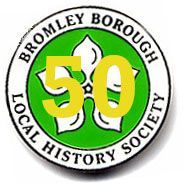A large part of (he area north of Bromley stretching towards
the hamlet of Catford, was once known as Plaistow. It was
mostly pastural land containing not only rustic farmhouses
and labourers’ cottages, but also a few grand estates and
high class residences. The area was served by narrow
winding lanes and paths. There were in the area four
estates; Plaistow Lodge, Plaistow Hall, Springhill and Milk
Street. Plaistow Lodge, which was the largest covered about
126 acres and stretched north from London Lane, once
known as Boyd’s Lane, after an occupier of Plaistow Lodge,
and the estate included all the land west of Burnt Ash Lane.
It was bought by Peter Thellusson in 1777, and he then had
Plaistow Lodge built at a cost of £40,000. The estate passed
through a number of hands and in 1873 was bought by the
Hon. Arthur Kinnaird, the father of Arthur Fitzgerald
Kinnaird, who was born on 16 February, 1847, and
succeeded his father in 1887 to become the 11th Baron
Kinnaird of Rossie.
Lord Kinnaird left Plaistow Lodge in 1896 and the estate
was then developed. Quernmore school had outgrown its
accommodation in Holwood Road, and Plaistow Lodge
became the Quernmore School we know today.
Before these changes had taken place, Lord Kinnaird had
become the most conspicuous name in the ranks of British
w footballers, and this position was retained throughout his
life; even when he had long since ceased to play football. In
1868 he had joined the Council of the Football Association
and after being Hon. Treasurer for three years, he became
in 1890, President of the Association and held that position
until his death in 1923.
He played football for Eton when he was 14 years of age,
and at Trinity, Cambridge, he was captain of the college
association football club. The sport was not then the great
attraction it is today and the newspapers of the time hardly
mention football, but he is described in the old records as
the “fleet footed Kinnaird” . He played for the Old Etonians
and the Corinthians; and was in 9 cup ties and on the
winning side five times. He normally played as a half-back,
but on at least one occasion he played in goal. He played for
Scotland against England three times. He gained the
reputation of being one of the finest players of the day, and
once Lady Kinnaird reproached him for his robust play.
“One of these days you will be coming home with a broken
leg”. “Ah, yes,” he replied, “but it will be somebody else’s”.
The last occasion when his broad hefty figure was seen
playing football was in a veterans’ match, when he was 48
years of age. He always played in white flannel trousers.
There is no record of him playing football at Bromley,
although he always took a great interest in local sporting
activities and local affairs.
Plaistow Lodge
His activities were indeed diverse. He was an athlete and a
low churchman with an interest in a wide range of
philanthropic activities. For many years he was President of
the Y.M.C.A., he was Lord High Commissioner to the
Church of Scotland from 1907 to 1909; he was a Director of
Barclays Bank; he would address boy convicts in prison and
on one occasion he made a daring voyage round the south
end of the Isle of Skye in a canoe. It is recorded that he
owned about 11,600 acres of land.
His interest in local affairs is indicated by his joining a
deputation to the Ecclesiastical Commissioners in 1878 to
persuade them to sell Martins Hill to the local Board of
Works so that it could be made available for the public to
enjoy. In 1886 the Bromley Park Lawn Tennis club was
formed and Lord Kinnaird was its President.
Arthur Fitzgerald Kinnaird, F.R.G.S., D.L., J.P., —
Baron Kinnaird of Rossie — died on 30 January, 1923, at 10
St. James' Square, S.W.I., when he was nearly 76 years of
age, and eleven days after his wife, to whom he had been
married for 48 years.
Bromleag Magazine September 1976
